#japanese firemen
Text

"BOY, WHERE'S THE FIRE?" -- HOW TO SIGNIFY A FIREFIGHT IN THE EDO PERIOD.
Artist: Utagawa Yoshitora.
Title: The Flowers of Edo Children's Amusement; Fireman, First Squad, "Yo" Brigade.
Date: c. 1858
Details: ARC Ukiyo-e Database
Source: The Metropolitan Museum of Art, USA.
Source: https://ukiyo-e.org/image/met/DP148993.
#Edo Fireman#Edo#Edo Period#Edo Japan#Yoshitora Utagawa#Utagawa Yoshitora#Met#The Met Museum#Metropolitan Museum of Art#Met Museum#The Met#Japanese Woodblock#The Flowers of Edo Children's Amusements#Yoshitora Utagawa Artist#Yoshitora Utagawa Art#Japanese Woodblock Art Print#Matoi#Japanese#Flowers of Edo#Japanese Art#Japanese Style#Japan#Utagawa Yoshitora Art#Edo Japan Art#Japanese Firemen#Edo Firemen#Art Print#Japanese Art Print#Utagawa Yoshitora Artist#The Metropolitan Museum of Art
11 notes
·
View notes
Text

Lance Week '22 Super-Delayed Cross-Post no.4 - 'New Job'!
So anyone who follows me will know this has been my beloved headcannon for over a year now - Air-Sea/Mountain Rescue Lance!
It makes so much sense - his costume designs and colours from Gen 3 on, Dragonite's pokedex entries about benevolently saving drowning sailors in the wild, never mind with a trainer, his proclivity for heroics and proximity to the super-dangerous Mount Silver... I could go on xD
Anyhoot, please enjoy some slices across time, featuring a man in a variety of eye-searing, plastic-y trousers!
#pokemon lance#champion lance#wataru#galar#hammerlocke#johto#mount silver#indigo league#trapinch#kairyu#dragonite#drakloak#british firemen#japanese firemen#ABC Work#photographs#This basically rewired my brain when I first came up with the concept xD#The synergy is too good!#I do still enjoy Secret Agent Man Lance#But I enjoy this more!
54 notes
·
View notes
Text

Kaneko Kunio
Firemen's Coat - Megumi- Ichiban
2003.
#kaneko kunio#woodcut#japanese woodblock print#block printing#japanese art#asian art#japan#japanese culture#art history#modern art#happi coat#firemen#clothes#textile art#tumblrstyle#tumblr art#artists on tumblr#tumblraesthetic#aesthetictumblr#tumblrposts#tumblrlove#beautiful
8 notes
·
View notes
Text

一件 19 世紀的日本消防員外套,上面裝飾著一隻盤旋在廢棄圍棋棋盤上的蜘蛛。
A 19th century Japanese Firemen’s coat decorated with a spider hovering over an abandoned Go board.
-from "Museum Of Artifacts"history blog-
an early-nineteenth-century firefighter’s coat, called hikeshibanten, since it features a spooky spider. Made in the Edo period in Japan, these firefighter’s coats were reversible, and this design is actually on the interior of the jacket, only visible when the jacket has been turned inside out. A large spider—with an endearing face—looms over the shoulder of the jacket, where it hovers menacingly over an abandoned go board (Pacific Northwesterners may have unnerving flashbacks to the giant house spiders that descend on Seattle in the autumn). The range of tonalities centers on indigo, white, black, and greyish-brown, with red accents on the fan; this color palette visually unites the work, creating parallels between the spider’s eyes and the go pieces.
The method of dyeing used, tsutsugaki, is a type of resist dyeing. The design was drawn on the cotton using rice paste, and these initial lines are visible now as the lightest areas of the design. The spider and the go board were dyed their respective colors, and covered with more rice paste to block any other dye from entering the area. Then the fabric was dipped into indigo multiple times, dried, soaked in hot water again, and the rice paste was scraped off to reveal the layering of colors; this whole process could take 20 days.
The scene is from the story of the warrior-hero Minamoto no Yorimitsu (948–1021) who, once when sick, was visited by an evil priest in the guise of a giant spider. Yorimitsu saw through the disguise and attacked the spider priest, and his four attendants (who were playing a game of Go while guarding him) leapt up to track the intruder back to his den.
5 notes
·
View notes
Text

A 19th century Japanese Firemen’s coat decorated with a spider hovering over an abandoned Go board.
2K notes
·
View notes
Text

Fireman's Coat
Late 19th Century to Early 20th Century
Japan
Japanese firemen's coats are reversible. When fighting fires, the coat was worn as shown, together with close-fitting trousers, a hood, and gloves. Saturated with water, these garments gave protection against flames. A bold, legible pattern on the back identified the fireman’s brigade. For festive occasions, the pictorial side faced outward. This coat shows the Toad Spirit offering to teach the robber Jiraya magic, provided he used it only to benefit humanity.
Denver Art Museum (Accession Number: 1999.265)
#coat#outerwear#fashion history#historical fashion#non western fashion#japanese fashion#late 19th century#early 20th century#turn of the century#1880s#1890s#1900s#1910s#denver art museum
1K notes
·
View notes
Text
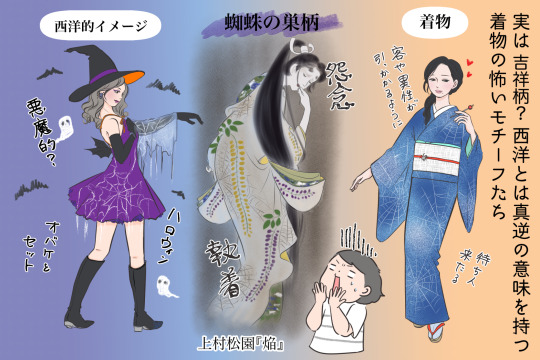
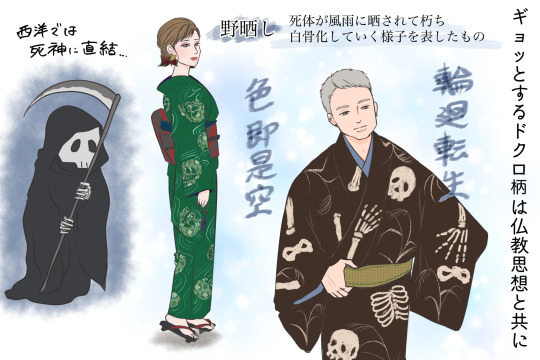


Lovely article+illustrations by Kimono Ichiba (via Tanpopo <3), overviewing famous "scary"patterns... which are in fact often auspicious as traditional Japanese patterns ;)
I believe I have them all on the blog somewhere but it's nice having them in one place so let's go!
Spiderwebs (kumo no su)
In ancient China, spider were seen as auspicious messengers connecting Heaven to Earth.
As the spider catches its prey in its web, spiderweb came to signify "grasping happiness".
Apparently during Edo period, prostitutes and geisha used spiderweb patterned items as a good luck charm (meaning something like "this customer will come back").
A very famous spiderweb depiction is the Lady Rokujo ukiyoe [焔 honô (the flame of passion)] by female artist Uemura Shoen. Wisteria caught in the web could mean ``I hope [Prince Genji] will come tonight'' which is pretty sad considering her story T_T
Skulls (dokuro)
Exact name for human remains pattern is "nozarashi" (lit. "weather beaten") ie bones scattered in a field. This depicts a corpse turned to bones/unveiled from its grave by the elements.
Skulls are thought to ward off evil and bad luck. Bones can also symbolize a do-or-die spirit, or hope for rebirth after death.
OP stresses a theory linking bones pattern to a buddhist saying 色即是空 shikisokuzekū "form is emptiness, matter is void, all is vanity". An interpetation is that we'll all turn to dust one day so we're all equal.
Bones patterns are often seen during Obon (Festival of the dead) season.
Monsters, ogres and ghosts (yôkai / oni / yûrei)
Monsters patterns were then worn to ward off bad luck and evil spirits. Reasoning is: let's repel scary things by wearing an even scarier monster!
Fearsome monsters were especially use by people with dangerous jobs, like Edo period firemen.
Firemen often had the lining of their heavy fire attire (火事装束 kajishouzoku) embelished with lavish designs of brave heroes and fantastic monsters. It was both a talisman and a way to show that they did not fear danger or death.
Another reason behing monsters patterns is the Edo period love for "scary" entertainements, be it ghost stories, parlor or other types of games, art (see for ex. Utagawa Kuniyoshi), etc. And Edo city dwellers were all about being fashionable so a monster pattern would have been considered quite iki!
#japan#art#history#pattern history#kimono#obi#halloween#spider#spiderweb#kumo#kumo no su#skull#skeleton#dokuro#nozarashi#weather beaten bones#obon#monster#youkai#oni#ghost#yurei#firemen#kajishouzoku#kaidan#ghost stories#Hyakumonogatari Kaidankai#One Hundred Supernatural Tales#Kimodameshi#Test of courage
869 notes
·
View notes
Text
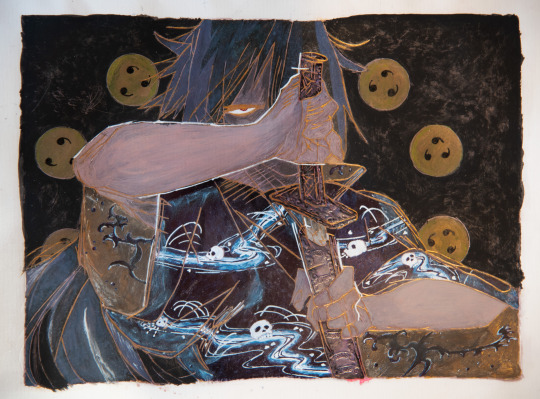
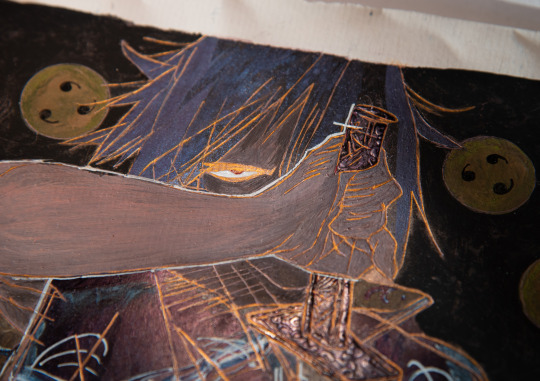
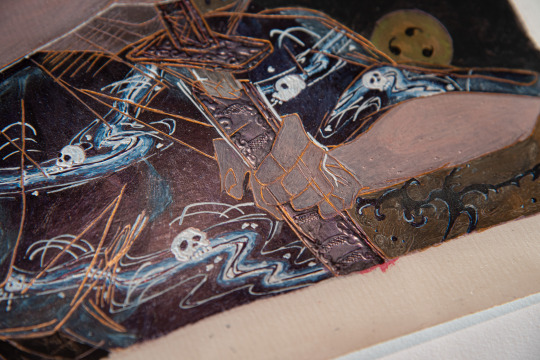
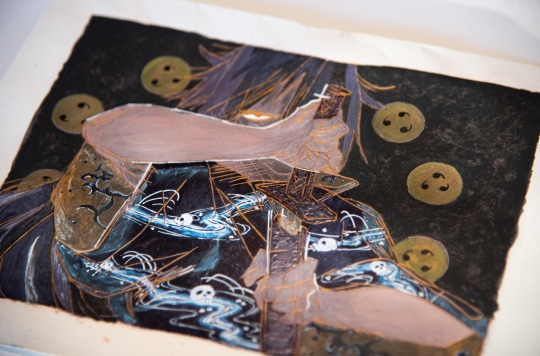
Another year, another outfit to die in! Happy birthday again Izuna!!!!!!
Like last year, I played with someone else's lines for these charming patterns, thank you so much Lena @elhnrt ! I had a ton of fun :D
Check the readmore for pattern references and explanations, there are some easter eggs in there :)
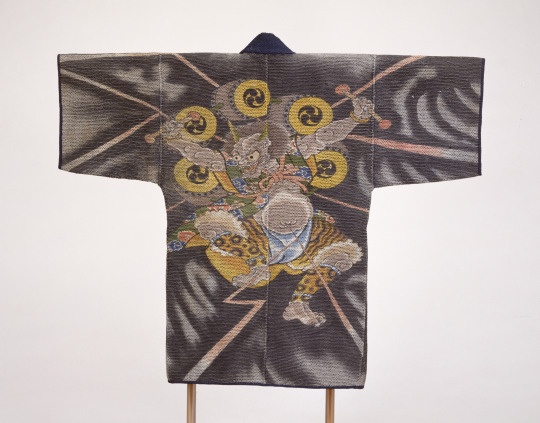
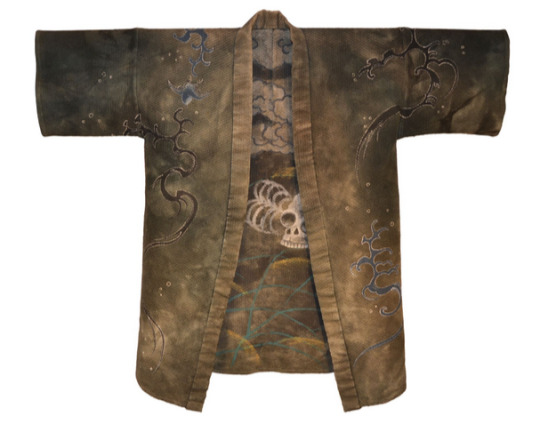

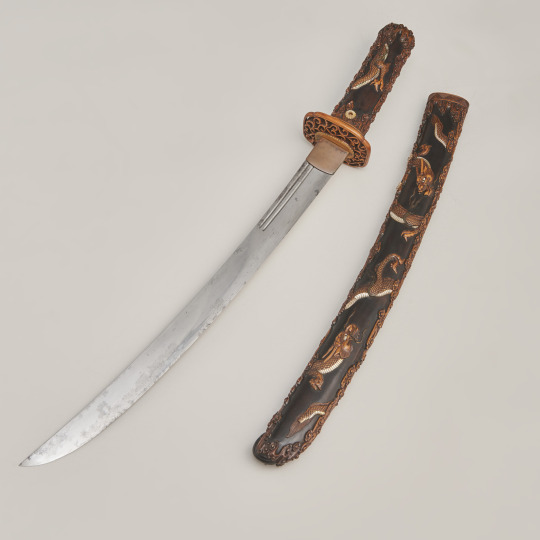
(x,x,x,x)
My goal for this piece, in addition to playing with patterns and textures and adding some Naruto references, was to add as many death flags as possible.
The idea of having Izuna in a fireman's coat is obviously not from me. I've always like the idea of Uchihas in fire resistant clothes, and the opportunity for a thick texture alongside a reversible double pattern is very appealing. I used the image of the second reference as a base, with skulls on one side and stylized lightning patterns on the other (visible inside the sleeves and collar). Both were common immagery of firemen coats.
The actual skull pattern is taken from the third reference. I'd seen this one before and before even learning anything abt it it was too beautiful to pass up. Those white and navy gradients are absolutely delightful and I enjoyed using my gel pens for them very much.... This particular type of imagery with skulls and bones in a field is called Nozarashi, inspired by Buddhist representation of death and transience.
The lightning pattern itself is a reference to water and lightning dragons :) Like Tobirama's iconic jutsu, it's one of the hints of what's abt to happen to our little guy. The scabbard is also decorated with dragon motifs for the same reason.
The background pattern is taken from the first reference, another fireman's coat with an illustration of Raijin, the thunder god. He is often representated with drums decorated with tomoes. It works nicely as a standard looking sharingan illustration, with a reference to Tobirama's hiraishingiris with the thunder imagery, like the thunder patterns inside the coat.
If you're interested in this I recommend the book linked in the second reference! It is entirely about skeleton motifs in japanese clothing of the early 20th century.
#mine#mixed#wip#naruto#uchiha izuna#been looking at some many fun patters I really went all in for this one#I love borrowing people's lines bc I do not care much abt anatomy or even drawing clothes tbh but patterns and textures....#it's like I'm dressing up a little doll :)#you can tell I was feeling myself seriousposting bc I capizalized the names...#anyway this was a lot of fun and of course actually quite unserious#for exemple you'll notice all these are either from late 19th/early20th c. despite the warring states era being obviously sengoku coded#later designs were easier for me to find references from and information on since I do not know much abt the subject#I allowed myself these liberties bc the timeline (wether aesthetic or narrative) in naruto is hardly strict#also it's usually the senjus who are associated with Buddhism and the uchiha are more shinto leaning but well.#you can tell yourself this is a sign of early konoha corruption on our guy Izuna#if you have any more questions abt this feel free to ask! this was a surprise again so i haven't posted any wips#but i do have some pictures of the process and I always love to chat
200 notes
·
View notes
Text
The art director & the Good Omens book cover tier list of doom, part 2
Part 1 l Part 2
I am your resident Art Director/Good Omens enthusiast, and welcome to my completely meta-free book cover tier list. Listen, making a book cover is HARD. I should know. But while we salute these artists for their hard work and time, I think we can all admit that once in a while, the vision is just not on. And on very rare occasions, publishers seemed to have managed to commission the cover art directly from hell... here's where we left off last time:

Onwards and upwards, as they say.
11. International paperbacks, Goda Omen

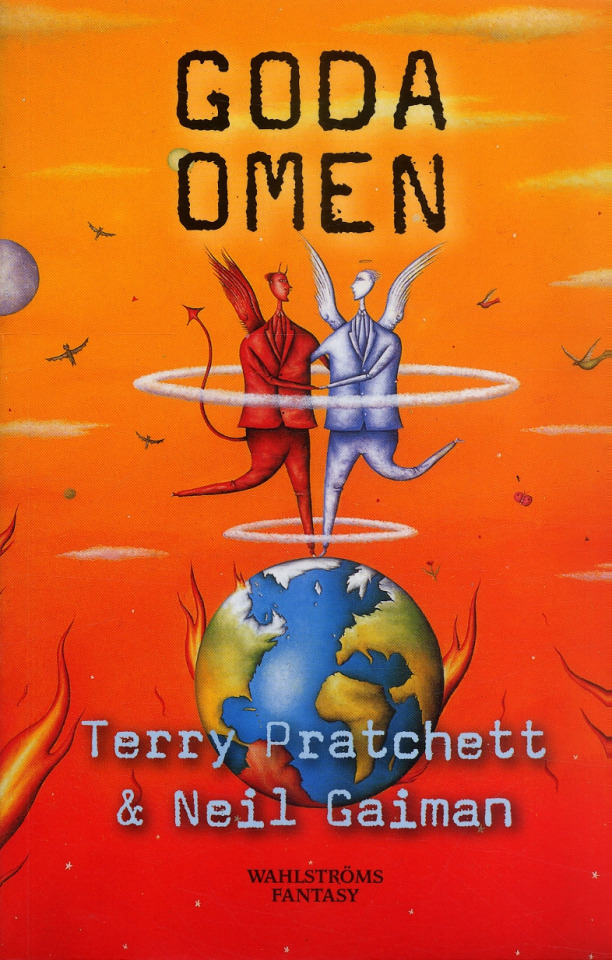
It is inexplicable to me but I LOVE this cover art. It's so sweet and innocent, the colours are contrasty and fun, and the layout leaves enough room for the text. Maybe I would call it slightly inaccurate to have our boys dancing on Greenland while the UK has drowned in a great flood, but hey. It's charming. The international cover gets a thwack with a ruler for trying to fit "creator of Discworld" in between the two wings like that, though.
Tier: Great
12. Italian Cover, Buona Apocalisse à tutti!
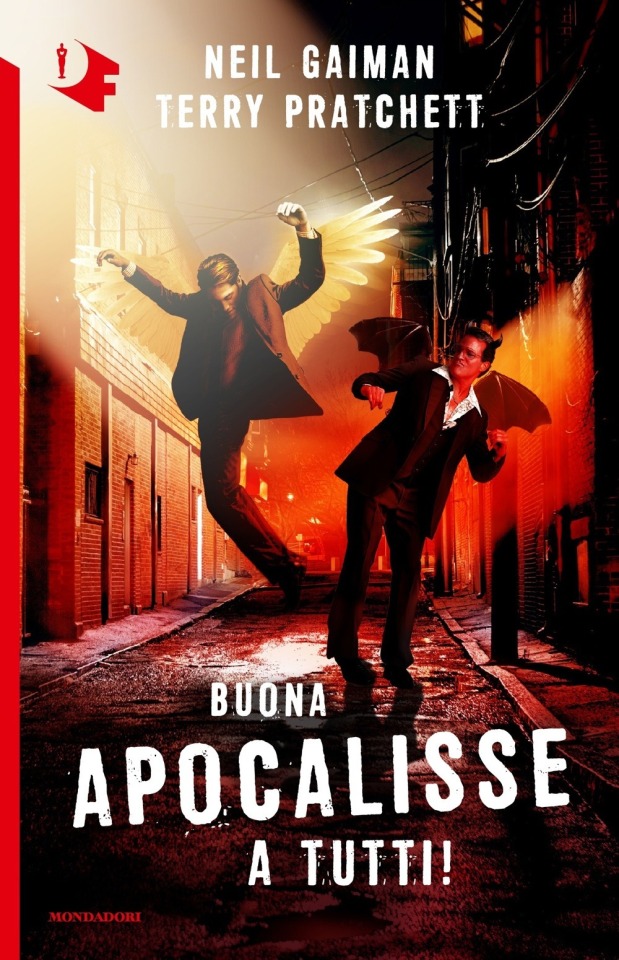
The Italian translation of Good Omens into "Happy Apocalypse to All!" really tickles my funny bone. Unlike this cover which is trying to scrape at it with a dull knife until I'm screaming on the floor. I know demons can only dance badly, but does Crowley *really* have to fracture both ankles while trying? Aziraphale pelvic thrusting his way into heaven is a visual I didn't think I'd ever want. Minus so many points for random murder alley where this is all occurring. At least the designer managed to wrangle the type into one of the best proportional layouts I've seen thus far?
Tier: Bad
13. Italian Cover, Good Omens
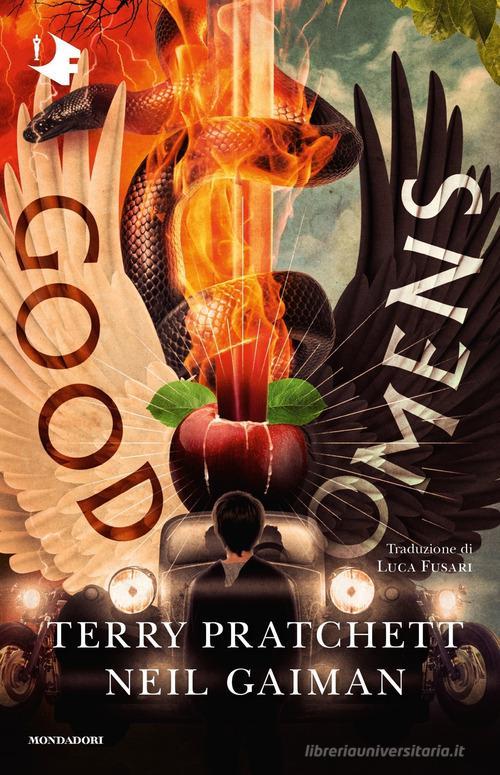
A truly valiant attempt here to rectify a terrifying situation with that earlier Italian version. While this one actually seems much more interesting at a glance, the details kinda get to me. The Bentley's steering being on the wrong side, the word Omens kindasortanotfquite fitting on the black wing, the motorcycles with no drivers... TIMES NEW ROMAN FOR THE AUTHORS NAMES. I don't think it can even be redeemed by the most powerfully rendered Sacred Heart/Cardi B W.A.P. imagery I've ever seen.
Tier: Good (Omens)
14. Japanese cover, Good Omens
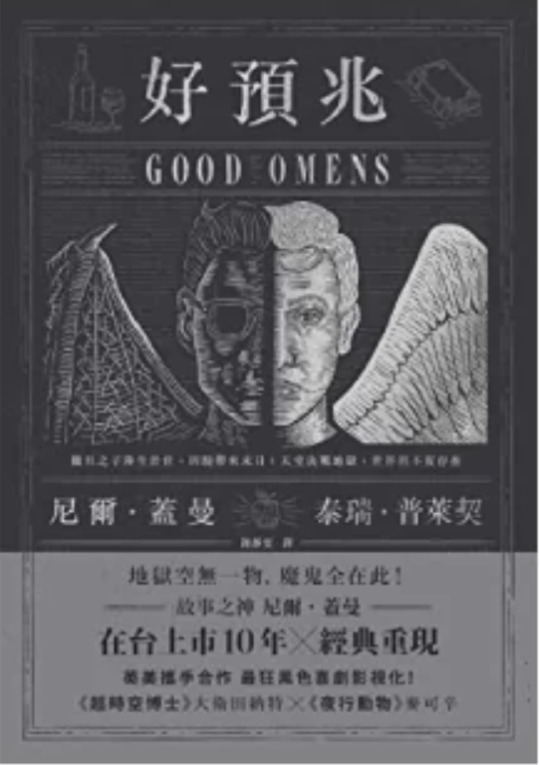
Look, this designer GETS IT. Crowley and Aziraphale are a pair, a group of the two of us. Do not separate. It's also the only cover I've seen that uses shades of grey! The woodcut vibes are STRONG AND POWERFUL. The type is well placed! I should love this, except the end result kinda looks like a manual for clinical depression in the workplace? It's ending up higher on the list than it deserves, frankly.
Tier: Good (Omens)
15. Japanese cover, Good Omens

This cover might as well be an Ethereal/Occult firemen's calendar. Someone wanted teens to cut off this cover and tape it to their bedroom wall. I can't even judge the typography or the symbolism because I'm just getting hit with waves of pheromones and angst. I can't even tell if it's good but it's going in the Good pile because I can't look at it anymore...
Tier: Good (Omens)
16. Japanese covers, Good Omens


Other people have assured me that this is, in fact, a dual Good omens cover. Alas, I cannot tell. I don't possess compound eyes or even an exoskeleton, and as such lack the ability to decipher these decisions.
Tier: WTF
16. Japanese cover, Good Omens
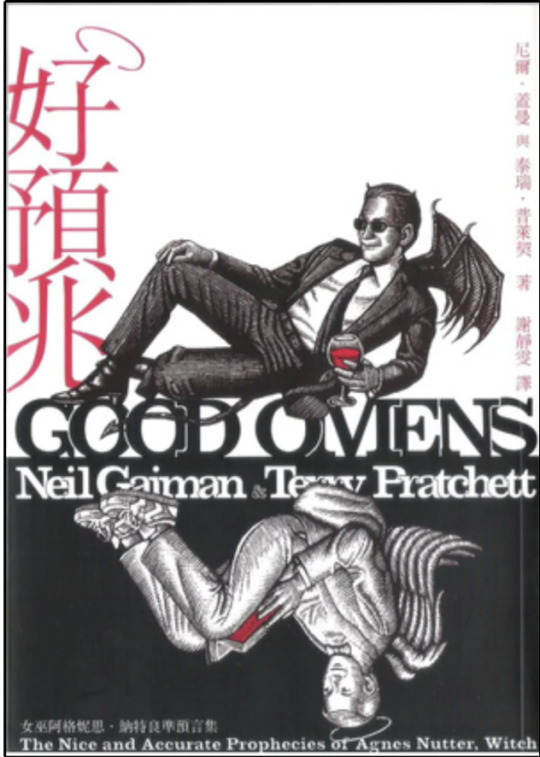
Holy overlap, Batman! I can’t fault this designer for wanting to reuse the wonderful dual illustrations in a Ying-Yang layout, all the elements are there, but there’s a clinginess to the type and positioning that makes me feel like someone is trying to hurt the letters? Is this designer okay? Do they need a hug?
Tier: Does the Job
18. Chinese cover, Good Omens

Can I say how charming it is they’ve managed to conserve the halo and devils tale on the Chinese title, as well as the woodcut detailing? However, the simplicity of the cute, contrasting wing design is sadly swallowed by the intense, New-York taxi cab vibes coming off the yellow and checkerboard text block. It could have been so good! Chinese readers: I am mad on your behalf!
Tier: Not so good (Omens)
19. UK 1991 paperback, Good Omens
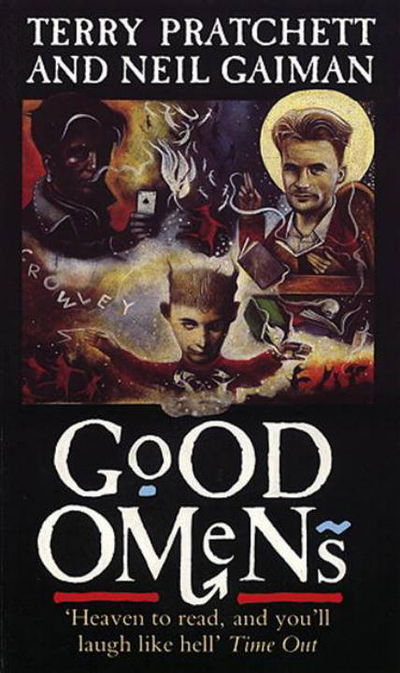
What are we doing here, people. I think I've stepped into a Jungian analysis of what it feels like to have read Good Omens. It's dreamy yet unsettling. Right yet very wrong. And Ol' "Tiny Hands" Aziraphale up there is really judging me for what they found inside my mind. In less upsetting news, we've kept the improved typography and layout of the authors and book title. All is not lost to the nightmare.
Tier: Not so good (Omens)
20. 50 Shades of Gray rip-off cover, Good Omens
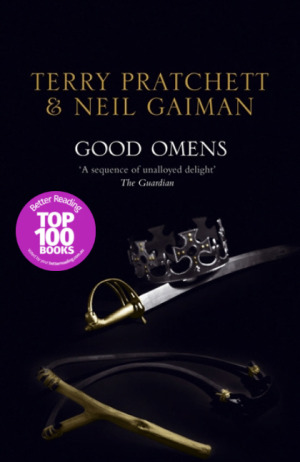
*panic* WHAT ARE WE DOING HERE, PEOPLE...?!
Bonus : the guardian quote is almost as much of a mystery as the cover it’s on.
Tier: WTF

End of round 2.
#good omens 2#art director talks good omens#tier list#good omens#aziraphale and crowley#aziraphale x crowley#crowley and aziraphale#book omens#book cover#go2
109 notes
·
View notes
Text

Matoi (Firemen), by Utagawa Kuniyoshi, 19th century
#ukiyoe#japanese art#japanese prints#woodblock printing#japanese woodblock#ukiyo-e#woodblock print#woodblock art#utagawa kuniyoshi
113 notes
·
View notes
Text


KAWABAORI
Reversible leather (deerskin or water buffalo leather imported from India) coats were worn by high- ranking Japanese firemen, merchants and carpenters in the Edo period.
These coats called kawabaori were made of thick smoked leather (fusube-gawa).
The design was made with a particular smoking process (inden) which seems to have been introduced to Japan from India in the Momoyama Period (1568-1603).
This technique allowed to impart color the leather and to render it waterproof. Before the smoking dyeing process, rice paste was applied with a stencil onto the leather to create a pattern reserved in white on the brown smoked leather.
Leather with inden smoking technique of dyeing
84 (h) x 123 cm
Japan, Edo period, 19th Century
27 notes
·
View notes
Text



THE ART OF FIREFIGHTING IN THE EDO PERIOD.
PIC(S) INFO: Mega spotlight on a Japanese woodblock print of Edo Fireman with matoi standard, c. 1860, artwork by Yoshitora Utagawa (active circa 1840 - 1880).
OVERVIEW: "A great design from Yoshitora's series "The Flowers of Edo Children's Amusements," a 64 print series depicting each of the 64 fire brigades in Edo. The term "Flowers of Edo" in the title here refers to fires. Each print features a portrait of a fireman holding his company's unique matoi, a fringed standard used to signal the location of a fire. Each wears a quilted jacket that could be wetted before firefighting for protection. A rarely seen series depicting these heroic firefighters."
-- FUJI ARTS (Japanese Art Print Auction house)
Source: www.fujiarts.com/edo-era-japanese-prints/yoshitora/951343-edo-fireman-with-standard-1860.
#Japanese Woodblock#Japanese Fireman#Edo#The Flowers of Edo Children's Amusements#Yoshitora Utagawa Artist#Yoshitora Utagawa Art#Japanese Woodblock Art Print#Art Prints#Art Print#Japanese Art Print#Matoi#Japanese#Japanese Woodblock Art Prints#Edo Period#Edo Japan#Flowers of Edo#Japanese Art#🗾#Japanese Style#Japanese Art Prints#Japan#Utagawa Yoshitora Artist#Utagawa Yoshitora Art#Edo Japan Art#Japanese Firemen#Edo Fireman#Edo Firemen#1860s#1860#Utagawa Yoshitora
7 notes
·
View notes
Text
Irezumi | Traditional Japanese Tattooing
Originally, Irezumi reflected social status or occupation, often seen on firemen, laborers, and Yakuza members. Common motifs are Koi fish, Samurai, Dragons, and Oni. It often covers large abode areas, with each tattoo telling a unique story reflecting the wearer’s life experiences, values, and aspirations. It ultimately represents a person journey of growth and transformation.




#irezumi#tattoo design#tattoos#japan#japanese#traditional art#traditional tattoo#history#tattooing#tattoo inspo#body modification#art
4 notes
·
View notes
Text
9 favourite books
Thank you @gwiazdziarka for tagging me (and thanks for all those book recs, I’m adding all of them to my list, except for the ones that I’ve already read), and I agree, maybe all of these won’t be my absolute favorite books, but they’re either books that I think about a lot, or books that have a special place in my heart, but not necessarily something that I go back to over and over.
The Little Prince by Antoine de Saint Exúpery
This one is definitely a favorite. It’s a book that I’ve reread many times, because I feel that it has a different feel every time, depending on what I’m going through at that moment. Also a classic. Love it so much that I’ve started to collect editions in different languages; so far I have Spanish (of course), French, Italian, Chinese, Korean, Japanese, Euskera (possibly one of the rarest), and Swedish (of course, because I intend to be able to read it by next year).
Neverwhere by Neil Gaiman
Also an absolute favorite, classic down-the-rabbit-hole type story that takes place in London Below. Fell in love with it, with the world-building within an already existing world. If i actually had to list 9 of my favorite books, pretty sure the whole list would be Neil Gaiman, but this book is both entertaining and comforting, so I pick this one. The BBC radio drama adaptation starring James McAvoy and Natalie Dormer is also excellent. Still waiting for the book sequel, though…
84 Charing Cross Road by Helene Hanff
The most charming book in history, composed entirely of letters between an aspiring writer and rare books collector in New York and the manager of a rare books bookshop in London. Their relationship is platonic, and yet one of the most romantic things I have ever read. The movie adaptation is equally charming and it has Anthony Hopkins and Judi Dench in it. Read the book first, then watch the movie, then cry endlessly. Rinse and repeat.
Like a Hole in the Head by Jen Banbury
You should know that I get a lot of book recommendations from TV shows, so I decided to hunt down this book when Monica was reading it in more than one episode of Friends (felt like a subliminal message). And it was fucking worth it. Also a book about a book. A dwarf comes into a bookshop where the protagonist works, to sell a first edition of Jack London’s White Fang, and only after he’s gone she finds out just how rare it is. Heist plot ensues. It’s equally strange and exciting, mind-blowing and cathartic.
The Opposite of Loneliness by Marina Keegan
Very melancholy, this book is a collection of essays, poems and short stories published posthumously, as Keegan died in an accident at 21. She was very talented and could write convincingly about many things. Can’t even pick a favorite one out of the collection, because they’re all very good in very different ways. Very bittersweet.
Los Caballos Estornudan en la Lluvia by Dimas Lidio Pitty
Another short story collection (the title literally translates as “Horses Sneeze in the Rain”), from a Panamanian author, from the region where I spent my childhood summers, which still holds a very special place in my heart, and which has a mysticism about it that he helps preserve in these stories. Dimas Lidio Pitty was very good at magical realism. One of the stories in particular is so brief, but it’s incredible how good it is in such a short narration.
Fahrenheit 451 by Ray Bradbury
I’m a huge fan of classic dystopic science fiction, and this one has got to be my favorite. The narrative is interesting, moves along at an excellent pace, and it covers everything. Another book about books too. If you haven’t read Fahrenheit 451, the premise is simple: in this dystopic society, firemen don’t put out fires, they start them… to burn books. Book banning to the extreme. What happens next? You need to read it to find out.
El Misterio del Solitario by Jostein Gaarder
I have been obsessed with this book (The Solitaire Mystery in English) by Norwegian author Jostein Gaarder since I started reading all his books when I was a teen (I don’t even know how I came across him, I just picked one up one day and went with it, it wasn’t even Sophy’s World, it was Through a Glass, Darkly). Of course Sophy’s World is probably the most famous, and it was very good, but this one is so strange and magical that I read it several times ages ago, and it was such a comforting book, and now I would like to reread. Maybe one day soon I’ll read it in Norwegian!
The Wizard of Oz by L. Frank Baum
Another classic and favorite, which I have also read many times. Some people like Alice in Wonderland, some like Peter Pan, I like the Wizard of Oz. I like anything Oz related, the movie, the musical, Wicked (the musical, not the book, tho), everything. But the source material is still where it’s at.
No pressure tags: @makingupachangingmind , @voldiebeth , @raincitygirl76 and @phoebenpiperx .
#booksbooksbooks#booklove#book recs#i love learning about what people are reading or have read or love to read#give me all the book recs#i wish i could have a book club with everyone here
9 notes
·
View notes
Text



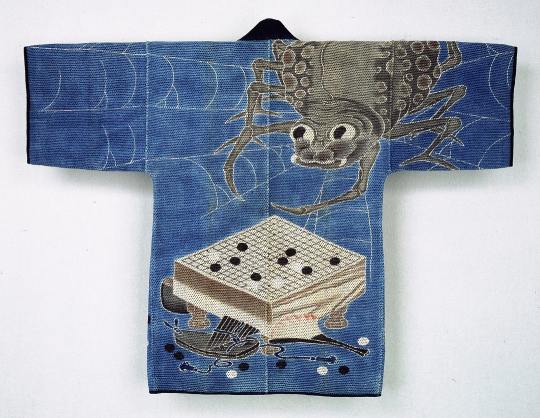


19th century Japanese Firemen’s Coats
Each firefighter in a given brigade was outfitted with a special reversible coat (hikeshi banten), plain but for the name of the brigade on one side and decorated with richly symbolic imagery on the other. Made of several layers of quilted cotton fabric, using a process called the sashiko technique, and resist-dyed using the tsutsugaki method, these coats would be worn plain-side out and thoroughly soaked in water before the firefighters entered the scene of the blaze.
1. The wizard Jiraiya turning into a giant toad
2. A scene famous from prints and Kabuki plays - the samurai Sato Tadanobu, ambushed by enemies while playing the game Go, is unable to reach his weapons so defends himself with the game's heavy wooden table, scattering the black and white stone game pieces
3. Interlocking circles, Chinese characters (Kanji) and ginkgo leaves
4. A spider hovering over an abandoned Go board
5. A tiger and dragon motif
6. A dragon motif
3 notes
·
View notes
Text
Alright. I have to talk about this.
I always thought Smokey the Bear was a bear cub someone rescued from a forest fire, and then someone else decided to make him a mascot for fire prevention. Fine. Good on you. Everyone wins.
I thought this because in 1976, Disney republished a Little Golden Book from 1955 about Smokey the Bear, paired with a 33⅓ record that read the book to you. I grew up with these "record books," so this was the version of the story I knew.
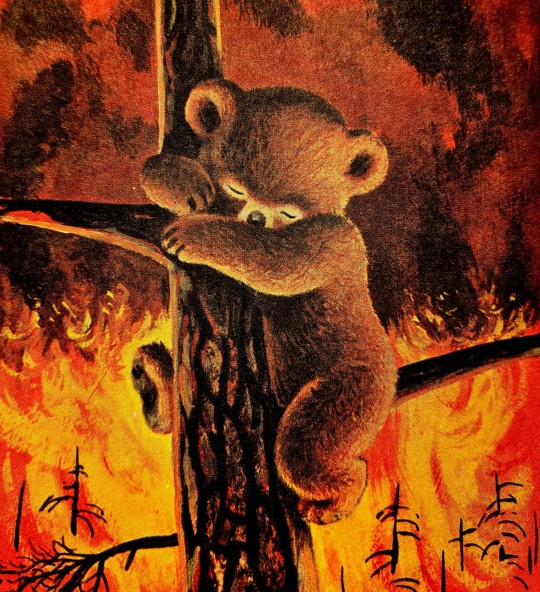

Except that isn't what happened.
Smokey the Bear - an adult bear in jeans and a park rangers' cap, who warns everyone about fires - is a thing from World War II, specifically 1944. The Japanese had decided that a cool way to terrorize America was to launch fire balloons into the Jet Stream, to set California's forests on fire. And they almost did it, a couple of times, and killed like 5 people. Plus the war was on, so all the regular burly firemen who would fight any forest fires were off shooting Nazis or Japanese soldiers. So Smokey was created to remind the public to be particularly vigilant about preventing and reporting forest fires.
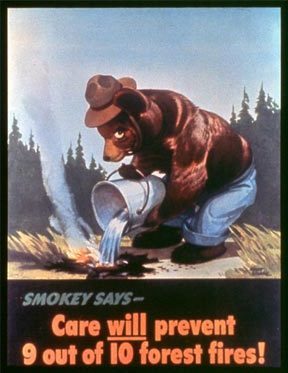
This is the original poster from 1944 by Albert Staehle.
In 1947 they came up with "ONLY YOU!...CAN PREVENT FOREST FIRES!"
Notice how none of this has anything to do whatsoever with any real-life goddamn bear.
In 1950, firefighters rescued a BLACK bear cub in New Mexico, who had climbed a tree to escape a fire. They named him Hotfoot Teddy and a forest ranger took him home as a pet. At some point before 1955, they had renamed him to Smokey the Bear, and he was sent to the National Zoo in Washington D.C., where he lived for 26 years.
The Little Golden Book version only shows him as an adorable BROWN cub: the age makes sense, because by 1955 he would have still been a roughly 40 lbs sub-adult. That is, the "REAL" Smokey the Bear, who people recognized from the papers.
...Except that was a black bear. But I guess newsprint is all black and white so...?
But this record book version is from 1976, ironically, the year the real adult bear died. I always remember thinking it was weird that he was a cub in this version, because other than this, in my world of the early 90s, he was always just the big bear in the hat.
I just...I thought he was a real bear first. Like...I feel betrayed, here. And stupid. This isn't secret knowledge. Wikipedia explains it. I had just never Googled Smokey the Bear.
Because I should not have had to.
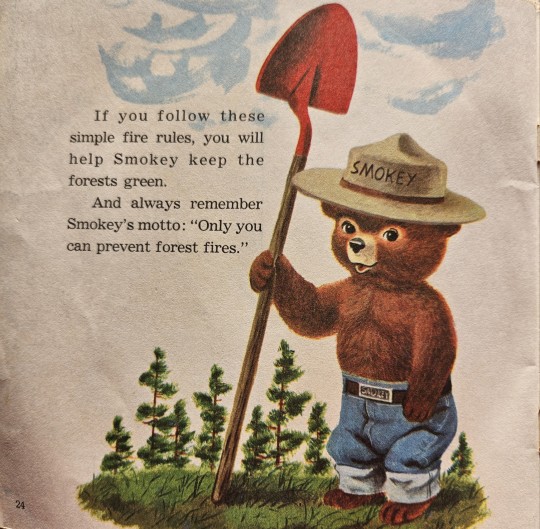
Also I didn't know the US government had enslaved a bear for propaganda purposes for 26 years. Probably should have rehabilitated him and either released him into the wild, or if he couldn't handle that, a quiet bear sanctuary.
Did they even have those in the 50s? Probably not.
At least in 1984, they gave him a fake tree filled with honey and berries:

3 notes
·
View notes